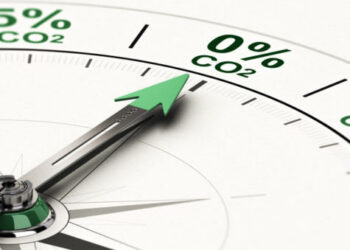The International Council on Clean Transportation (ICCT) has published a report focusing on the environmental impact of shipping emissions in the Arctic, specifically those connected to EU-regulated shipping activity.
The EU aims to reduce shipping emissions as part of its Arctic climate strategy and so far, it has mainly assessed emissions from EU-flagged ships. However, many more ships travel to and from EU ports through the Arctic, meaning earlier estimates may significantly understate the EU’s true impact. A new study by ICCT called “Black carbon and CO2 emissions from EU-regulated shipping in the Arctic” has expanded the scope by also assessing and highlighting emissions from ships traveling to and from EU ports.
Furthermore the study compares the fleet composition, fuel use, and Black Carbon (BC) and CO2 emissions of these ships across both the broadly-defined Geographic Arctic (north of 59°N) and the IMO Arctic as defined by the International Maritime Organization (IMO) Polar Code.
Key findings of the report:
- In 2021, nearly three-quarters of the ships operating in the Geographic Arctic and half of those in the IMO Arctic were navigating to or from EU ports.
- In 2021, ships flagged to Norway burned the most fuel by mass in the Geographic Arctic, while Russian-flagged ships burned the most in the IMO Arctic.
- Black carbon emissions in the IMO Arctic nearly doubled between 2015 and 2021. In 2021, Arctic shipping emitted 1.5 kt of BC and 12 kt of CO₂ north of 59°N, with about a quarter of these emissions occurring within the boundaries of the IMO Arctic. This indicates a strong growth trend in BC emissions in the IMO Arctic, from 193 tonnes in 2015 to 413 tonnes in 2021.
- Black carbon and CO₂ emissions from EU-regulated ships of at least 5,000 GT are nearly double those from EU-flagged ships. In the Geographic Arctic, EU-regulated ships contributed 44% of BC emissions and 60% of CO₂ emissions from ships at or above 5,000 GT, while EU-flagged vessels accounted for 20% and 23%, respectively.

Geographic Arctic
In 2021, shipping in the Geographic Arctic emitted approximately 1.5 kt of BC and 12 kt of CO2, with about a quarter of these emissions occurring within the IMO Arctic. Notably, estimated BC emissions in the IMO Arctic have nearly doubled since 2015.
Fishing vessels were the most common ship type in both the Geographic and IMO Arctic in 2021, contributing 27% and 32% of the total BC emissions in these regions, respectively. For vessels over 5,000 GT, bulk carriers, general cargo ships, and oil tankers made up the largest share, collectively responsible for 43% and 69% of BC emissions in the Geographic and IMO Arctic, respectively. The study indicates that a significant portion of the fleet operating in Arctic waters is connected to EU ports.
Specifically, 73% of ships over 5,000 GT in the Geographic Arctic and 49% in the IMO Arctic reported to the EU MRV system. The BC and CO2 emissions from EU-regulated ships were nearly double those from EU-flagged ships. In the Geographic Arctic, EU-regulated ships accounted for 44% of BC emissions and 60% of CO2 emissions, compared with only 20% of BC emissions and 23% of CO2 emissions from EU-flagged ships alone.
IMO Arctic
In the IMO Arctic, EU-regulated ships were responsible for 23% of BC emissions and 49% of CO2 emissions, against 12% and 20%, respectively, for EU-flagged vessels. These results highlight the significant role of EU-regulated shipping in contributing to both BC and CO2 emissions in the Arctic, and the need for more comprehensive policies that extend beyond EU-flagged vessels.
While shipping is recognized as a significant source of BC pollution, the European Union’s approach to quantifying its emissions in the Arctic has focused on EU-flagged ships. Moreover, BC emissions have not been included in the scope of EU maritime policies under the “Fit for 55” package, such as FuelEU Maritime and the extension of the EU Emissions Trading System to the maritime sector.
Policy recommendations
To reduce Black Carbon emissions in the Arctic from ships operating to and from EU ports, the following measures could be considered:
- Accounting for BC emissions in the EU MRV database would provide a more comprehensive assessment of the European Union’s role in shipping-related BC emissions, both globally and in the Arctic. Currently, the EU MRV system only mandates the reporting of CO₂, CH₄, and N₂O emissions from maritime transport.
- Recognizing BC as a significant climate pollutant would support the European Union’s efforts to mitigate its climate footprint in the Arctic and help inform policy measures, such as future revisions of the EU Emissions Trading System and FuelEU Maritime.
- Replacing residual fuel with distillate could reduce BC emissions by 50%–80%, depending on engine type and operating conditions. For EU-regulated ships over 5,000 GT in the Geographic Arctic, this would cut BC emissions by 115–183 tonnes—a 16%–25% reduction of the total BC emissions in this size category. Installing diesel particulate filters could increase the emission reductions to 206 tonnes, achieving a 29% total BC emissions reduction from ships over 5,000 GT sailing in the Geographic Arctic.
Our findings show that ships connected to EU trade, regardless of their flag, are major drivers of black carbon pollution in the Arctic. Recognizing these emissions in future policies could help the EU better align its climate goals with its real footprint in the Arctic.
…said Liudmila Osipova, ICCT Senior Researcher and lead author of the study.































































